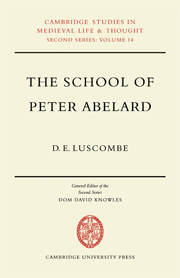Book contents
- Frontmatter
- Contents
- Preface
- List of Abbreviations
- I The Literary Evidence
- II Abelard's Followers
- III The Diffusion of Abelardian Writings
- IV The Condemnation of 1140
- V The Theological Writings of Abelard's Closest Disciples
- VI The School of Laon
- VII Hugh of St Victor
- VIII The Summa Sententiarum
- IX Abelard and the Decretum of Gratian
- X Abelard's Disciples and the School of St Victor
- XI Peter Lombard
- XII Robert of Melun
- XIII Richard of St Victor
- XIV Conclusion
- Appendices
- Bibliography
- Index of Manuscripts
- General Index
VII - Hugh of St Victor
Published online by Cambridge University Press: 05 November 2011
- Frontmatter
- Contents
- Preface
- List of Abbreviations
- I The Literary Evidence
- II Abelard's Followers
- III The Diffusion of Abelardian Writings
- IV The Condemnation of 1140
- V The Theological Writings of Abelard's Closest Disciples
- VI The School of Laon
- VII Hugh of St Victor
- VIII The Summa Sententiarum
- IX Abelard and the Decretum of Gratian
- X Abelard's Disciples and the School of St Victor
- XI Peter Lombard
- XII Robert of Melun
- XIII Richard of St Victor
- XIV Conclusion
- Appendices
- Bibliography
- Index of Manuscripts
- General Index
Summary
Abelard claimed to have had a part in the foundation of the house of Saint Victor in Paris by William of Champeaux in 1108. Hc claimed to have put William to flight from the schools to seek the shelter of the cloister. The scorn which he poured upon William's conversion could not have been quickly forgotten in that quarter, although in time it was matched by the ravings of Walter against his Minotaur. The main features, however, of the Victorine reaction to Abelard's teaching were not merely impatience or violence. No two Victorine masters are wholly alike, but the group of thinkers who were in the house between the 1120s and 1160s undertook patiently to censor, amend, absorb and surpass Abelard's theological production. A readiness to censure defects was graced with a striving to provide alternative theses by means of a scholarship which rivalled that of Abelard himself.
The abbey's rapid rise to fame was stimulated by its situation close to the schools of Paris and by its own opening of a school for students who were not themselves canons of the house. Among the canons there developed a remarkably distinguished circle of scholars. St Victor was a vital centre for the promotion of the vita communis, the canonical ideal which, if less spectacular than the new monastic initiatives, was still so fertile an element in the life of the eleventh and twelfth centuries. The spirituality of the regular canons of St Victor rivals that of the early Cistercians; Hugh and Richard, as masters of spiritual thought and writing, enjoyed a fame comparable with that of Bernard of Clairvaux and William of St Thierry.
- Type
- Chapter
- Information
- The School of Peter AbelardThe Influence of Abelard's Thought in the Early Scholastic Period, pp. 183 - 197Publisher: Cambridge University PressPrint publication year: 1969

